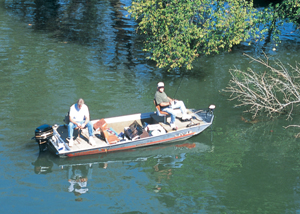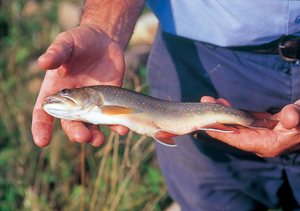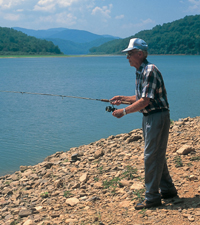Drop
A Line In Virginia's Favorite Fishing Holes
Photos
and Story by
Emily Grey, Contributing Writer

Whether
your prefer casting from a pier or wading in after your quarry,
Virginia offers a myriad of opportunities for anglers. |
Virginia
offers a wide variety of fishing opportunities and a temperate climate
that allows year-round participation in one of the nation�s most popular
sports.
Following is a
review of some of the state�s favorite fishing holes.
Criteria for
inclusion in this list are accessibility, trophy species, fish diversity,
environmental safety, and geographical balance. Neighboring creeks,
tributaries, inlets, and private ponds may yield a terrific bounty.
Remember, a license is now required to fish in
saltwater � the ocean in addition to the bay � and freshwater. Special
permits and fees are required in certain areas for trout and other stocked
fish.
The name of the game is fun. So, grab a rod, bait,
lunchbox, cooler, fishing license, and lucky cap, tee-shirt or vest, and
head for the place where reels sing.
Saltwater
Fishing
|

Chesapeake
Bay Bridge Tunnel. |
1. Confluence:
Chesapeake Bay/Atlantic Ocean
North America�s largest and most productive
estuary, the Chesapeake Bay, merges with the ocean and tidal rivers to
produce a mecca of fish-spawning and nursery sites. Some of the world�s
finest fishing is found here.
On a typical summer day, anglers try their luck on
the Chesapeake Bay Bridge Tunnel�s 625-foot-long fishing pier on Gull
Island. This southernmost pull-off with a restaurant and gift shop is 3.5
miles from the Virginia Beach mainland. Naval and ocean-going vessels pass
through this renown shipping lane.
Wrecks, 5,200 pilings, and stone riprap afford
excellent cover for bluefish, gray trout, and croaker. Spring ushers black
drum, summer brings spot, cobia, and red drum, and fall offers rockfish
and flounder.
|

Wachapreague
Marina |
Additional ramps are located at Cape Charles and
Kiptopeke State Park on Virginia�s Eastern Shore and Virginia Beach and
the Northern Neck.
2.
Intracoastal Waterway/Atlantic Ocean
Sheltered by the Eastern Shore of Virginia�s
unspoiled barrier islands, the Intracoastal Waterway (running 1,550 miles
from Boston to Florida Bay) and inlets serve as migratory routes for many
fish. Perch, shark, speckled trout, eel, and Spanish mackerel are a few
examples of what may be hooked off Virginia�s coast.
Well-known spots off Buoy #10 near Wachapreague, the
world�s flounder capital, include Concrete Pipe Stacks, Igloos, and
Parramore Reef. Look for sea bass in spring and fall and tautog in winter.
Hardy souls venture into the Atlantic at 21 or 26
Mile Hill or beyond where giant keepers await. Blue and white marlin, king
mackerel, dolphin (fish), wahoo, bluefin tuna, and yellowfin tuna (at
Lumpy Bottom), will test the strength of lines and grit of a fisherman or
woman.
|

Nottoway
River |
The Wachapreague Marina and Restaurant furnishes
gear, bait, skiff rentals, and tasty meals. Other public launch sites are
located in Oyster, Red Bank, Willis Wharf, and Chincoteague.
Brackish and
Freshwater Fishing
Brackish, fresh-tidal and non-tidal waters present
different angling opportunities. Virginia�s rivers, ponds and lakes
afford hours of angling delight and rewards.
3. James River
|

Brook
Trout |
From the confluence of the Cowpasture and Jackson
rivers downstream to Richmond, the James offers a diverse fishery. Anglers
find a bounty of smallmouth bass, rock bass and redbreast sunfish above
Richmond. Largemouth bass inhabit the river below the fall line at
Richmond.
Some of Virginia�s best jumbo blue and flathead
catfish are found in the lower (tidal) James. Watch for black crappie in
creeks and main stem oxbows upstream of Hopewell. In spring, anadromous
striped bass (rockfish) are caught near the I-95 Bridge at Richmond. In
fall, try the James River Bridge, Monitor-Merrimac Bridge, and around the
�mothball fleet.� A restoration program for American shad is under way
on this lovely watercourse.
Public access in the tidal James is available at
Ancarrow Landing (downstream of I-95 in Richmond), Deep Bottom in Henrico
County, Dutch Gap in Chesterfield County, and Lawnes Creek Landing in
Surry County.
4.
Rappahannock River
This river flows about 184 miles from its origin in
Fauquier County�s Chester Gap to the Chesapeake Bay. The initial 62
miles from the headwaters to Fredericksburg�s Mayfield Bridge are
designated a state scenic river.
Although the Rappahannock currently holds the state
record for channel catfish, blue catfish and white catfish also thrive
here. Based on electro-fishing samples, the best chances for blue catfish
are a few miles from Leedstown downstream to Fredericksburg. Largemouth
bass, bluegills, yellow perch, crappie, and white perch are also
plentiful. Shad and herring are available in spring.
Mott�s Landing (Route 618) in Spotsylvania County
offers a canoe/jon-boat slide while Tappahannock�s Hoskin�s Creek and
the City of Fredericksburg have boat ramps. Barrier-free sites include
Kelly�s Ford (Route 672 off Route 651) in Culpeper County and Mill
Creek, Mill Stone, and Saluda in Middlesex County.
5. Lake Anna
Impounded in 1972 to furnish cooling water for the
North Anna Nuclear Power Station, Lake Anna is located in Louisa, Orange,
and Spotsylvania counties. Submerged brush-and-cinderblock shelters
benefit an assortment of fish.
Striped bass, largemouth bass and black crappie are
found along boat docks and bridges. Walleye inhabit drop-offs in the
Pamunkey River arm above Terry�s Run from February through April. White
perch in winter, bluegill, and channel catfish are also sought.
Nine marinas, one public boat ramp, several
campgrounds, motels, and Lake Anna State Park provide access to the
9,600-acre lake. A handicapped-accessible catwalk for anglers is available
at Dike #3 on Route 622.
6. Shenandoah
River, South Fork
|

Shenandoah
River |
This fork begins at the confluence of the North and
South rivers near Port Republic and flows north 97 miles to meet the North
Fork Shenandoah at Front Royal. Largemouth bass fishing is excellent.
Opportunities are also favorable for finding smallmouth bass, redbreast
sunfish, pumpkinseed, bluegill, channel catfish, crappie, rock bass, and
muskellunge.
Portions of the river are contaminated. Keep an eye
out for signs posted along the river notifying anglers of contaminants.
7. Lake Moomaw
In Bath and Alleghany counties, this picturesque
2,530-acre flood-control reservoir was completed in 1981 when the
Gathright Dam closed. The result is 43 miles of shoreline with a 12-mile
backup into the Jackson River.
|

Lake
Moomaw |
March, April, October and early November offer the
best angling. Summer night fishing in the shallows also yields positive
results. McConaughy-strain rainbow trout, crappie, channel catfish, chain
pickerel, bluegills, redear sunfish, yellow perch, largemouth and
smallmouth bass provide wonderful sport in this lake. A cold layer, 15
feet below the surface, teems with stocked rainbow, brook, and brown
trout.
Boat ramps are available at Coles Mountain and
Fortney Branch. A handicapped-accessible fishing pier is located at Bolar
Flats on the lake�s northern end.
8. Nottoway
River
Originating in Nottoway County, this minimally
developed scenic river evolves into the Chowan in North Carolina.
Smallmouth bass, largemouth bass, catfish, bluegills, yellow perch, black
crappie, and redbreast sunfish abound. Trophy redear sunfish are found in
Southampton County. Shad and herring fishing is good March through May.
Rare in other Virginia rivers, the Roanoke bass
thrives in the Nottoway. Generally, they are found in the river�s upper
reaches in summer and further downstream in winter. Gar and bowfins also
inhabit the lower portions of the river.
Public ramps include Hercules Landing, Carey�s
Bridge, Peter�s Bridge, and Route 258 near Riverdale. In summer, anglers
can wade the shallows upstream of Courtland.
|

Buggs
Island Lake |
9. Buggs
Island Lake (Kerr Reservoir)
Along the central Virginia-North Carolina line, this
48,900-acre lake offers a diverse warm-water fishery.
Largemouth bass, crappie, blue catfish, flathead
catfish, striped bass and white bass are popular at Buggs Island. In fall
and winter, the most promising catfishing area is from Goat Island to the
Clarksville Bridge. February to April is the time to fish for crappie in
Bluestone, Buffalo, Butcher, and Grassy creeks.
Virginia fishing licenses are legal throughout the
lake. The North Bend Park pier is designed for disabled anglers. Another
convenient access and camping area is Occoneechee State Park. For
information on water levels, contact the U.S. Army Corps of Engineers at
(434) 738-6371.
10. Smith
River
Cool-water discharges from Philpott Dam
create 20 miles of some of Virginia�s best trout fishing
downstream to Martinsville. October to May (stocking season) offers a
rainbow trout bounty. From Town Creek downstream to Bassett, wild brown
trout are caught year-round.
Experts recommend bait fishing for rainbow trout and
catching browns on the fly. Walking and wading are the most effective
fishing techniques. Motels in Martinsville and cabins and camping at
Fairystone State Park are convenient.
Call the U.S. Army Corps of Engineers at (541)
629-2432 for Philpott�s weekly power-generation schedule.
11. New River
|

New
River |
This ancient, surprisingly clear waterway rises near
Boone, N.C., and reaches the West Virginia line 160 miles later. State
records have been set here for muskellunge and smallmouth bass. Please
return muskies with transmitters to the river.
Claytor Lake to Big Falls is excellent for trophy
largemouth bass. Flathead catfish, channel catfish and sunfish such as
redbreasts, bluegill, and rock bass are plentiful in many locations. March
and April are good times to find walleyes around Allisonia.
Austinville, Byllesby, and Pembroke are among the
many sites with boat ramps. Cabins are available at Claytor Lake State
Park, camping at New River State Park, and lodging in Wytheville, Galax,
and other nearby towns.
12. Holston
River, South Fork
|

Holston
River |
This section begins in Smyth County near Sugar Grove.
Walleye, which spawn in South Holston Lake, are caught near Alvaredo. From
early February through May, this species is often spotted in the river
above the lake and at Damascus. A white bass spawning run also comes from
the lake.
Trophy rainbow and brown trout are available
year-round on a catch-and-release basis within the VDGIF Buller Fish
Cultural Station. Check special regulations for the upper and lower
portions of this fork. Virginia Creeper Fly Fishing at (276) 628-3826 in
Abingdon provides helpful information.
Access is also available at Avens (South on Route 75
and left on Route 672) near Abingdon. Camp in Jefferson National Forest or
stay in motels in Marion or cabins in Hungry Mother State Park.
For
fishing regulations, access, and other facts,
contact:
Virginia
Department of Game and Inland Fisheries
4010
West Broad St.
Richmond,
VA 23230-1104
(804)
367-1000
www.dgif.state.va.us/fishing
Virginia
Marine Resources Commission
2600
Washington Ave.
Newport
News, VA 23607
(800)
541-4646 � (757) 247-2200
http://www.mrc.state.va.us/
index.htm
Virginia
Department of Health�s Fish Advisories
www.vdh.state.va.us/HHControl/
fishing_advisories.htm